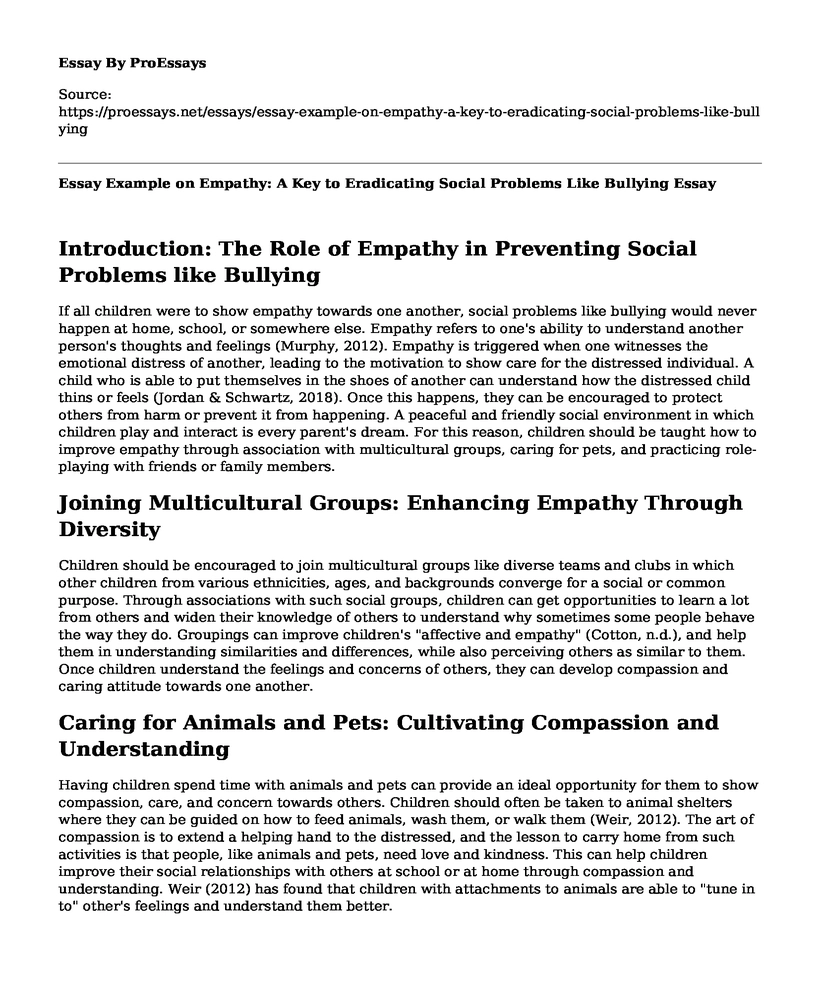Introduction: The Role of Empathy in Preventing Social Problems like Bullying
If all children were to show empathy towards one another, social problems like bullying would never happen at home, school, or somewhere else. Empathy refers to one's ability to understand another person's thoughts and feelings (Murphy, 2012). Empathy is triggered when one witnesses the emotional distress of another, leading to the motivation to show care for the distressed individual. A child who is able to put themselves in the shoes of another can understand how the distressed child thins or feels (Jordan & Schwartz, 2018). Once this happens, they can be encouraged to protect others from harm or prevent it from happening. A peaceful and friendly social environment in which children play and interact is every parent's dream. For this reason, children should be taught how to improve empathy through association with multicultural groups, caring for pets, and practicing role-playing with friends or family members.
Joining Multicultural Groups: Enhancing Empathy Through Diversity
Children should be encouraged to join multicultural groups like diverse teams and clubs in which other children from various ethnicities, ages, and backgrounds converge for a social or common purpose. Through associations with such social groups, children can get opportunities to learn a lot from others and widen their knowledge of others to understand why sometimes some people behave the way they do. Groupings can improve children's "affective and empathy" (Cotton, n.d.), and help them in understanding similarities and differences, while also perceiving others as similar to them. Once children understand the feelings and concerns of others, they can develop compassion and caring attitude towards one another.
Caring for Animals and Pets: Cultivating Compassion and Understanding
Having children spend time with animals and pets can provide an ideal opportunity for them to show compassion, care, and concern towards others. Children should often be taken to animal shelters where they can be guided on how to feed animals, wash them, or walk them (Weir, 2012). The art of compassion is to extend a helping hand to the distressed, and the lesson to carry home from such activities is that people, like animals and pets, need love and kindness. This can help children improve their social relationships with others at school or at home through compassion and understanding. Weir (2012) has found that children with attachments to animals are able to "tune in to" other's feelings and understand them better.
Children should be involved in practicing role-playing or role-taking as this activity is fundamental in having them play the fictional roles of others in distress. This activity provides children with opportunities to play out the feelings and thoughts of another person to provide them with wider perspectives of understanding other people. After activities like this, children boost their cognitive and affective empathy because they learn how to feel "someone else's pain" through "emotion sharing" (Dewar, 2009). Emotion sharing can create impulses that push children to react to others in distress and in need of help. It can also prevent a child from bullying another or causing them harm.
Conclusion
In conclusion, children should be taught how to show empathy towards one another in various settings, including at school and at home. Empathy-improving activities are numerous, including having children associated with diverse groups or clubs in which they can learn, visiting animal shelters and caring for pets, and having them undertake role-playing activities. These strategies can provide children with ideal conditions and opportunities to learn about other people and the importance of compassion. With a deeper and well-founded understanding among themselves, social issues like bullying, harassments and teasing among children would be greatly reduced. This reduction would create safe and friendly spaces in which children can develop and flourish into well-behaved and responsible people.
References
Cotton, K. Developing Empathy in Children and Youth [Ebook] (pp. 1-18). educationnorthwest.org. Retrieved from https://educationnorthwest.org/sites/default/files/developing-empathy-in-children-and-youth.pdf
Dewar, G. (2009). Teaching empathy: Evidence-based tips. Retrieved 2 December 2019, from https://www.parentingscience.com/teaching-empathy-tips.html
Jordan, J., & Schwartz, H. (2018). Radical Empathy in Teaching. New Directions For Teaching And Learning, 2018(153), 25-35. doi: 10.1002/tl.20278
Murphy, P. (2012). Your Brain On Fiction (pp. 321-322). Manhattan: New York Times.
Weir, K. (2012). Cool to Be Kind. Current Health Teens.
Cite this page
Essay Example on Empathy: A Key to Eradicating Social Problems Like Bullying. (2023, Mar 02). Retrieved from https://proessays.net/essays/essay-example-on-empathy-a-key-to-eradicating-social-problems-like-bullying
If you are the original author of this essay and no longer wish to have it published on the ProEssays website, please click below to request its removal:
- Testing the Strength of Supporting Material: George Bush 9/11 Speech
- Family Migration Experience Essay Example
- Gang Violence at Harper High School Essay Example
- US Special Forces' Battle for Tora Bora: 2001 Hunt for Bin Laden - Research Paper
- Immigration Reform: A Decade of Debate - Essay Sample
- John's Recurrent Depression: A Perfectionist's Undue Burden - Essay Sample
- Essay Example on Creating an Equitable Payment Plan: Dessler's Five-Step Process







